Dec 19, 2025
Dec 19, 2025
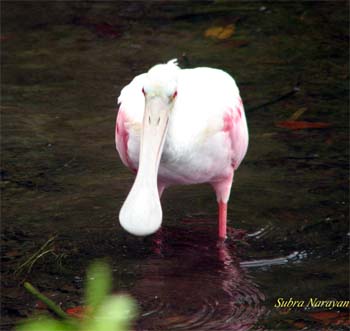 Tucked away in the Gulf of Mexico lie the twin islands of Sanibel and Captiva, off the coast of southwest Florida whose pristine shell filled beaches beckon the frigid northerner during winter. But more than the sunny beaches, an intrinsic part of this 12 mile long island is an incredible nature preserve, called the Ding Darling Natural Wildlife Reserve, where migratory birds from up north flock to this ecosystem for the winter. Just a few miles west of Ft. Myers, our first stop was at the Ding Darling visitor center which is filled with educational exhibits and a live feed of the birds in the sanctuary.
Tucked away in the Gulf of Mexico lie the twin islands of Sanibel and Captiva, off the coast of southwest Florida whose pristine shell filled beaches beckon the frigid northerner during winter. But more than the sunny beaches, an intrinsic part of this 12 mile long island is an incredible nature preserve, called the Ding Darling Natural Wildlife Reserve, where migratory birds from up north flock to this ecosystem for the winter. Just a few miles west of Ft. Myers, our first stop was at the Ding Darling visitor center which is filled with educational exhibits and a live feed of the birds in the sanctuary.
Thanks to the pioneering efforts of Pulitzer prize winning, political cartoonist, Jay Norwood ‘Ding’ Darling, way back in the 1940s, this lush tropical ecosystem covering 6000 acres is well preserved and offers an excellent opportunity to view birdlife and appreciate the compelling reasons for nature conservation. After going through the interactive exhibits and talking to the friendly and knowledgeable staff, we headed off for a 4 mile ride on ‘Wildlife drive’ through the heart of the sanctuary, where you can pull up at convenient spots and immerse yourself amidst nature.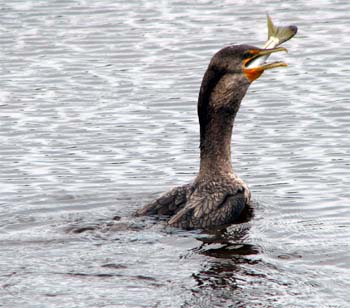 The serene setting of this unique mangrove ecosystem is filled with migratory birds that bring warmth to your heart. As I focused on the Tricolored Heron, a couple of White Ibises with their distinct long curved red bills flew in and settled down while in the distance several Roseate spoonbills in their pink plumage were fishing. A Great Blue Heron was intently concentrating in trying to get its next meal. It was truly blissful and indeed captivating to witness nature at work in this calm and serene setting, so near and yet so far away from the hubbub of civilization!
The serene setting of this unique mangrove ecosystem is filled with migratory birds that bring warmth to your heart. As I focused on the Tricolored Heron, a couple of White Ibises with their distinct long curved red bills flew in and settled down while in the distance several Roseate spoonbills in their pink plumage were fishing. A Great Blue Heron was intently concentrating in trying to get its next meal. It was truly blissful and indeed captivating to witness nature at work in this calm and serene setting, so near and yet so far away from the hubbub of civilization!
A Snowy Egret gracefully walked in the shallow waters, marking a milestone as I spotted my 100th species since I started birding. An Osprey which is an endangered species flew in showing off its enormous wingspan and talons wide open as it came in for a landing. Wood Storks with their humongous beaks were gently probing for food using their feet to aid in the search. Little Blue Herons looked resplendent against the backdrop of the lush foliage. Lo and behold, a Double-crested Cormorant also known as the snake-bird appeared from below the surface of the water with a rather large mouthful! The birds seemed completely oblivious of the other two legged species, Homo Sapiens and were not afraid to venture closer.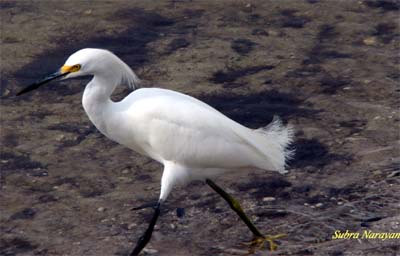 Congregating in the mudflats at low tide were majestic White Pelicans surrounded by at least fifty odd Sandpipers and a couple of Semi-palmated Plovers that were completely dwarfed by the pelicans. A Spotted Sandpiper and a Dunlin with its slight drooping bill wandered close enough to the banks. The Roseate spoonbills took off, soaring in the air effortlessly and it was delightful watching their colorful plumage fill the skies. Ding Darling is truly a birder’s paradise, but can equally be appreciated by the uninitiated too!
Congregating in the mudflats at low tide were majestic White Pelicans surrounded by at least fifty odd Sandpipers and a couple of Semi-palmated Plovers that were completely dwarfed by the pelicans. A Spotted Sandpiper and a Dunlin with its slight drooping bill wandered close enough to the banks. The Roseate spoonbills took off, soaring in the air effortlessly and it was delightful watching their colorful plumage fill the skies. Ding Darling is truly a birder’s paradise, but can equally be appreciated by the uninitiated too!
We drove off from Wildlife Drive to one of the shell filled quartz sand beaches where, to my delight, Common Terns were flying above the ocean and after a brief moment of suspended animation, they dove headlong straight into the waters to scoop their catch! Laughing Gulls were all over the place accepting leftovers that people were offering! Brown Pelicans would effortlessly lift off and fly in tandem. What a remarkable comeback for this bird from the brink of extinction, just a few years ago! A solitary Willet was running up and down the sandy beaches trying to forage for food as the waves kept dashing against the beach.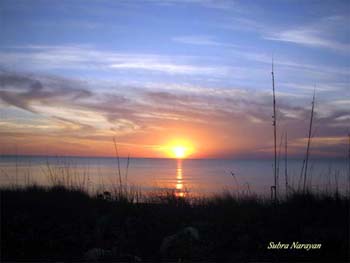 As we drove back from Sanibel Island, it was absolutely fascinating to catch a glimpse of the setting sun.
As we drove back from Sanibel Island, it was absolutely fascinating to catch a glimpse of the setting sun.
Our next stop was at the majestic Everglades National Park, a unique subtropical wetlands ecosystem, a two hour drive south of Sanibel. The Everglades was established as a national sanctuary once it was realized that this was a fragile living habitat that housed so much wildlife. Mangroves and cypress swamps and mahogany hammocks thrive in the Everglades. One of the three entrances to the Everglades takes you to the Gulf Coast visitor center where you can go by boat to see the mangroves that are an integral part of the estuary where fresh water meets the ocean. Watching an entire colony of Royal Terns on the islets was an incredibly beautiful sight; not something you get to see regularly. A short while later a pod of bottlenose dolphins showed up and frolicked in the waters much to everyone’s delight.
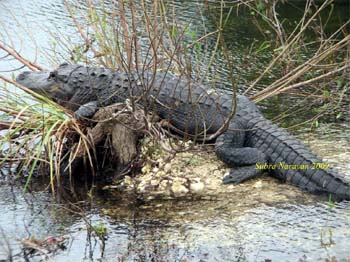 After an hour’s drive on Tamiami Trail, we reached the Shark Valley entrance to the Everglades for the 2 hour tram tour through the heart of the Everglades. This region covered with abundant saw-grass has been aptly described as the ‘river of grass’. Conservation efforts are ongoing to reverse the unbelievable levels of destruction caused over the years. Besides a wide variety of wading birds, the one ubiquitous inhabitant of this swamp is the American alligator. We spotted baby alligators that were only about 3 inches which eventually grow up to several feet long. Contrary to popular misconception that these bulky dinosaurs don’t move fast, typically alligators can easily outrun most humans. Halfway through the tram tour, you get to go up a 65 foot observation tower that gives a bird’s eye-view and allows you to drink in the awesome magnificence of the Everglades.
After an hour’s drive on Tamiami Trail, we reached the Shark Valley entrance to the Everglades for the 2 hour tram tour through the heart of the Everglades. This region covered with abundant saw-grass has been aptly described as the ‘river of grass’. Conservation efforts are ongoing to reverse the unbelievable levels of destruction caused over the years. Besides a wide variety of wading birds, the one ubiquitous inhabitant of this swamp is the American alligator. We spotted baby alligators that were only about 3 inches which eventually grow up to several feet long. Contrary to popular misconception that these bulky dinosaurs don’t move fast, typically alligators can easily outrun most humans. Halfway through the tram tour, you get to go up a 65 foot observation tower that gives a bird’s eye-view and allows you to drink in the awesome magnificence of the Everglades.
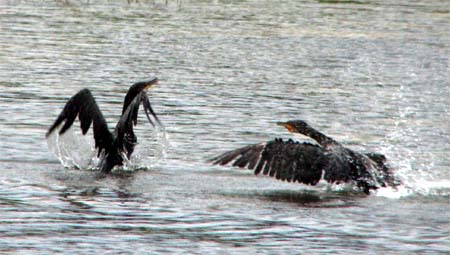 While we watched a flock of several White Ibises soar up in the air, we noticed a cormorant catch a fish but before it could swallow it, another cormorant appeared out of nowhere and made a fierce plunge for the delicacy. Soon a bitter fight ensued in the swamp until a clear victor emerged. One doesn’t get to witness such high drama in the mundane city based environs!
While we watched a flock of several White Ibises soar up in the air, we noticed a cormorant catch a fish but before it could swallow it, another cormorant appeared out of nowhere and made a fierce plunge for the delicacy. Soon a bitter fight ensued in the swamp until a clear victor emerged. One doesn’t get to witness such high drama in the mundane city based environs!
The next day we entered the park from the east entrance, to arrive at the Ernest Coe visitor center. Once inside the park you can drive up to the farthest tip in Flamingo while stopping enroute at various trails such as the Anhinga Trail, Gumbo Limbo trail, Pah-ay-okee, and the Mahogany trail where you can hike on boardwalks to enjoy nature’s bounty. We saw Green Herons hiding in the swampy marsh grass waiting to pounce on an unsuspecting prey, Little Blue Herons, male and female Anhinga’s sunbathing, noticed a Palm Warbler flitting in the bushes, Black Vultures, Turkey vulture and a Northern Mockingbird.
The phenomenal biodiversity of the Everglades and the interplay of nature in this delicate ecosystem leave an indelible impression on one’s mind and instill a deep sense of appreciation for nature conservation.
10-Jan-2010
More by : Subra Narayan